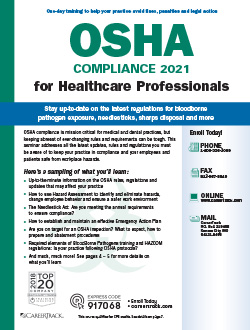Attention Medical and Dental Professionals:
OSHA has developed today's medical and dental practice standards to ensure a safe, hazard-free environment for you, your staff and your patients. You may be "pretty sure" or "almost certain" you're in compliance with OSHA's latest standards, but with OSHA, there's no margin for error. This seminar was designed to cut through the confusion and hone in on what you need to know to ensure your practice is fully compliant.
Noncompliance with OSHA is serious business, and can cost your practice dearly. In fact, a single citation for a serious violation can carry a monetary penalty of up to $7,000, while repeat violations may reach upwards of $70,000!
Don't just think you're in compliance … know you are!
In addition to complying with OSHA's general industry standards, medical and dental practices must also follow the OSHA guidelines, rules and regulations that apply specifically to medical hazards, risks and safety procedures.
<!--read more-->
Attend this seminar, and gain the very latest information on OSHA rules, regulations and guidelines for medical and dental practices. You'll learn how to:
- Log employee incidents properly
- Maintain records in accordance with OSHA's record-keeping requirements
- Pinpoint hidden or overlooked safety and health issues
- Establish a Hazard Communication program to keep hazard awareness current
- Ensure your practice is up-to-date on BBP, Needlestick and OPIM regulations
- Comply with Exit Route standards — signage, lighting, diagrams, markings
- Prepare for an OSHA inspection
- Promote a culture of safety throughout your entire practice
Just one day of focused training ensures your practice is OSHA compliant and inspection-ready.
